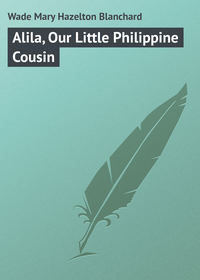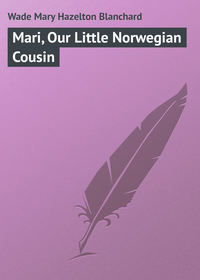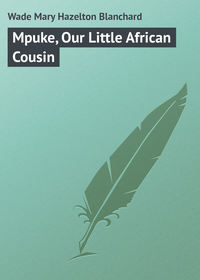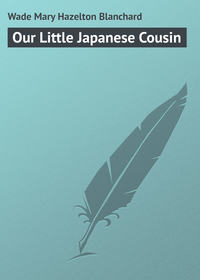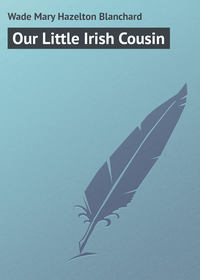 полная версия
полная версияLittle Folks of North America
Sometimes, as the children are playing around the camp in the evening, they hear a sudden screech in the distance. It is the cry of a wild-cat, or lynx. They would not care to have it take them by surprise, for it is a fierce creature, and its teeth and claws are very sharp. The men, however, hunt wild-cats and get many of them every year, because they are well paid for the skins.
Then there are foxes, silver and black and red. Many thousands of these sly creatures are shot or trapped every year in Canada. Sometimes a fox-cub is brought into the camp to amuse the children. It is a gentle, pretty creature at first, but before long it will show the ugly cunning of its parents.
The boys sometimes search for muskrats, whose homes are much like those of the beavers, a number of them always found together.
Off for the HuntThere are many half-breed children in Canada, as you already know. They grow up with a love of hunting like their Indian brothers. They dress in Indian fashion, wearing moccasins and leggings. Many of them live in rough log huts and sleep on piles of brush covered with fur robes. When the cold weather sets in, the Indian, and the half-breed boy as well, does what he can to help the men of the household get ready for the busiest work of the year, as the trapping and hunting season is at hand.
By the first of November the lakes and streams are frozen, and the winter coats of the wild animals are at their best. On a bright, frosty morning, often with the thermometer below zero, the trapper dresses himself in his thickest socks and moccasins, warm leggings and cloak. He fastens a fur cap down over his head and draws on his long fur mittens which reach up to his elbows. A hatchet, hunting knife, and fire-bag hang from his belt.
While he is dressing, his wife is busy preparing his pack, for he may be gone several days. The pack consists of a blanket, a kettle and cup, sugar and salt, tea, of which the Indians are very fond, and enough pemmican to last several days. Pemmican is dried meat ground fine and mixed with fat. If the trapper is not very poor he has steel traps and a gun to add to his pack. When it is ready, it is bound to a hand sledge which is simply a thin board curled up at one end. It is easily drawn over the snow, and at the end of the hunt is loaded with furs and game to carry home.
Now for the snow shoes! When these have been bound on his feet, the trapper can skim over the snow fields with the greatest ease, drawing his sledge behind him. He must not sing nor make any noise as he moves along; nor if he has any company can there be any loud talking. Otherwise the animals whom he seeks, might take fright and flee from danger, and this must not happen on any account.
Ah, how cold it is! the breath freezes as it leaves the mouth and nostrils, the eye-lashes become stiff with frost, but the hunter is too busy watching for signs of the prey he seeks, to think of these things. His hands and feet become numb with the biting cold, but this is only what he expected, and he trusts to his quick movements to keep them from freezing. At last the forest is reached and he turns his eyes in every direction for signs that animals have been near. A white man would see nothing, where an Indian or a half-breed reads whole pages in Mother Nature’s wonderful book.
Yes, a marten was here only an hour or two since and is still not very far away. A trap must be set up in this very spot and baited with dried meat, or with a tender piece of squirrel. Then the hunter creeps away, to seek places where there are other signs of life and to set up new traps while he waits. If he is after foxes or minks, he visits the shores of the lakes and swamps. He looks carefully about him now for the foot-marks of the fox, or the sharp, clear track of the mink.
When the evening comes the trapper looks about him for some place that is sheltered from the wind. There he makes a roaring fire, over which he brews a pot of tea. When this is ready, he enjoys his hot drink, together with a share of the pemmican brought from home. Next he gathers soft pine boughs for a bed, covers them with a blanket, and with his feet towards the fire, lies down for his night’s rest. Toward morning the fire burns low, and the cold grows so bitter that the man cannot sleep. He gets up, piles on more wood, and warms himself by the bright flames. Once more he stretches himself on his bed of boughs, hoping to sleep until the morning sunshine shall awaken him.
Winter SportsA great many of the white children of Canada live in Quebec and Ontario. Although these provinces lie in the southern part, yet the winter is very cold even there. The children enjoy it, however, because the air is clear and dry, and there is plenty of snow on the ground. Even the little folks learn how to use snow-shoes, and with these on their feet, they skim over the crusted snowfields like the wind.
They have many toboggan rides, too. Nothing could be pleasanter for a party of merry children, than to spend the morning coasting down the steep hillside on wooden sleds called toboggans, which are shaped much like the Indian hand-sledges. They move so fast over the snow, that the riders must hold on tightly lest they tumble out. Sometimes there is a sudden upset as the toboggan strikes a rough spot on the hillside. Then there is much laughing and shouting as the children pick themselves up, and make ready for a fresh start.
Perhaps the greatest sport of all is a ride on an ice-boat which is raised on large iron skates, and in a good wind will sail very swiftly. When the St. Lawrence River is frozen over, one can see numbers of ice-boats skimming along with their loads of happy passengers.
Of course the children of Canada skate and play hockey. The lakes and ponds are frozen over for many months, so that parties are continually made up for skating and games on the ice.
One must certainly not forget to mention sleigh-rides. There is no place in the world where the people enjoy sleigh-riding more. They wrap themselves up in warm furs, and spring into the pretty sleighs to which gaily decked horses are harnessed. Jingle, jingle, sound the bells, and when the word is given, away move the sleighs filled with their merry loads.
The Big CitiesAlthough Canada has been under English rule for a long time, yet many French people have continued to live there. In fact, in the province of Quebec there are more French than English. The old part of the city of Quebec looks much to-day as it did in the long ago, when Wolfe climbed the cliff and took the French army by surprise. Along the narrow streets there are many quaint old houses with peaked roofs, in whose gardens French-Canadian children play the games and sing the songs of France. Here and there you will see an altar on which flowers have been placed, and people bowing before the image of the Virgin Mary.
If you visit Quebec, you will certainly go to the citadel. Far above the water it stands, on the summit of the cliff, while just below it lies the old city, with its high, pointed roofs, and queer gates opening into old-fashioned gardens. Far, far below lies the beautiful St. Lawrence, where ships of many countries lie at anchor. Immense rafts of lumber come floating down the river, to be sent on the waiting ships to other lands. On some of these rafts are tiny houses for the men who have rowed them from the forests, hundreds of miles up the river.
Before you leave the city you will walk out on the Plains of Abraham which stretch into the country back of the citadel. There the great battle was fought that gave Canada to the English; and there in the summer of 1908 a great celebration was held. Three hundred years ago the city of Quebec was founded, and in memory of this, many thousands of people gathered to see the pageants, representing the great things that have happened there. The city was gay with flags and bright-colored banners. There were concerts, balls and grand dinners. The Prince of Wales himself was there to take part in the good time. The pageants were the best part of the celebration, of course. They were given on the Plains of Abraham, and hundreds of men, women and children took part. Thousands of people gathered in the open-air theatre to look on.
Montreal is another beautiful city. It is built on an island in the St. Lawrence River. Most of the children there are of French blood, but there are also many boys and girls of Irish, Scotch and English families. They are all proud of the wonderful bridge, nearly two miles long, that crosses the river at Montreal, and of the beautiful cathedral that will hold ten thousand people. They, as well as the children of Quebec, see ships of many countries anchored near their homes. Many of these ships have crossed the ocean to receive the lumber and furs that Canada wishes to send to other lands.
The capital of Canada is Ottawa, in the province of Ontario. It is also on the St. Lawrence. High up above the water, on the river banks, stand many beautiful buildings, where all the business of the government of Canada is carried on. Ottawa is a beautiful place for a home and the children who live there should be very happy. They have the winter sports of Quebec, while on the hot summer days they can sail in and out among the islands of the river, or picnic under the trees of the forests only a short distance away.
On the FarmsIn your grandfather’s time, few people except the Indians and halfbreeds, were living on the prairies over which Mackenzie made his way on his journey westward. There were no roads there in those days; no tracks over which trains filled with passengers went flying by. Great herds of buffaloes wandered about, feeding on the tall prairie grass, while here and there little red children ran in and out of their wigwams, and danced about the camp-fires.
To-day scarcely a buffalo is left in the land, the shriek of the steam engine is often heard, while many comfortable farm houses can be seen. In the summer time there is much to do, even for the little folks. The boys help weed the vegetable gardens, and care for the cows and the horses, while their fathers are busy in the fields of wheat and oats that stretch over many acres. The girls learn to darn and sew, as well as wash dishes and help their mothers make bread and pies for the hungry workmen.
Sometimes the farmer raises only hay, but the big crops must be cared for very carefully and the boys do their share of the work. Ranches where cattle and horses are raised are also found on the prairies. Certainly no place could be better for this work, since the broad acres of tall grass make the best feeding-grounds possible.
When August comes, the men and boys get out their guns and watch for the coming of the prairie chickens. Later on, the wild ducks and geese appear in large flocks. This is the time for the boys to take their canoes and a few supplies, and camp out on the shores of the lakes and ponds, for they know that the birds love the water and are sure to seek it. There will be feasting in the big farmhouses now, because there will be plenty of tender wild ducks to roast, and the cellars are full of the vegetables raised in the gardens.
Besides the autumn shooting and the feasts that follow, there are many other good times for the young folks on the big farms. They meet together for singing and dancing, they play tennis, they have games of hockey, both on land and ice, they have jolly sleigh rides in the frosty air, they skate and they curl, and, of course, the small boys and girls make snow-forts and houses that will last without melting for a month at a time. If you who live in warmer lands should pity them for having such long, cold winters and so much snow, the children would laugh at the idea. They would tell you that they love the winter and hate to have it come to an end. They can have such jolly times out of doors, and then, when they are tired of their rough sports, they can gather around roaring fires in the big living-rooms of the houses, and listen to the stories the older folks tell them of the days of long ago.
In a Lumber CampFor many years the white settlers in Canada have been busy cutting down trees in the big pine forests, yet they still stretch for many miles through the country. When the autumn comes the children of the lumber-men hear their fathers tell of the winter’s work before them. They are going out into the forests to live, and will not be home again for many months. A party of these lumber-men start out together. They carry everything they will need for their rough housekeeping, – a few kettles and dishes for cooking, some heavy blankets, a supply of flour for bread, salt-pork, tea and molasses.
The last good-bye is said and they start out on their long journey to the forests. As soon as they reach the place for the winter camp they set to work to build a house of logs. In the middle of the roof a place is left open, to let out the smoke when a fire is burning inside. Around the side of the big room, the men build bunks in which to sleep at night, and in the middle they make a fireplace, where the blazing logs on winter evenings will send out such warmth and cheer, that Jack Frost will not dare to venture through the cracks in the walls.
The lumber-men are happy in their work. All day long the sound of their axes rings through the forest, while they vie with each other in cutting down the big trees. Then when night comes and their supper of bread, tea and fried pork is finished, they gather around the fire to smoke and tell stories. The weeks pass quickly, and with the coming of spring, immense piles of logs are ready to go to the saw-mills.
When the ice begins to break up, it is a sign to the men to bind the logs into cribs. Thirty or forty logs are enough for one crib. The cribs are fastened together to form rafts, which are set floating down the rivers. Some of the men ride on the rafts and guide them by means of long poles tipped with steel, to prevent them from running aground. Others of the party go at once to the saw-mills, to be ready to receive the logs when they arrive. Buzz-z-z sounds through the air, as the big wheels turn and the trees of the forest are rapidly changed into strong lumber.
Beyond the MountainsLet us now cross the Rocky Mountains, and make a short visit in British Columbia. It is the most beautiful province in Canada, with its mountains covered with forests and its rivers stocked with fish. The children who live near the Fraser River, can tell wonderful fish stories, for at a certain time of the year, millions of salmon leave the ocean and make their way up this river. Then big folks and little are busy with nets, hauling in the fish and carrying them to the canneries.
Gold is also found on the Fraser River, while the mountains nearby are rich in other minerals.
The Klondike MinesFar up in the northwest of Canada, near the borders of Alaska, are the famous Klondike mines. You have probably heard of them, and of the long, hard journey a person must take to get there. Such wonderful stories have been told of the riches one can bring away from these mountains, that many a young man has left home and friends to seek his fortune there. Now-a-days it is easier to reach the Klondike mines than it was a few years ago, but the country is cold and dreary and most of the food must be brought from a distance, so that few white children have found their way there. Yet as they sit in their cosy homes, they are glad to listen to the stories of that wild country, told to them by the brave men who have been to the Klondike gold regions.
CHAPTER V
Little Folks of Labrador
East of the large bay where Henry Hudson lost his life is the peninsula of Labrador. Although it is farther south than Greenland or Alaska, its shores are very bleak and bare, because of cold winds that blow inland from the ocean. You can easily guess that this country is the home of Eskimos who seem the best fitted of all people to live in the lands of ice and snow.
Some white children are to be found there, however. Their fathers are fishermen who get a living for their families out of the icy waters of the ocean. Sometimes, too, they hunt the deer, or set traps for other wild animals. In the summer time the children search for birds’ eggs, and in the autumn the men and boys keep on the lookout for eider-ducks, wild swans, ducks, geese and ptarmigan. The meat of these birds is sweet and tender, while the feathers make warm beds, pillows and quilts.
The children of the fishermen paddle about in the rough waters in their canoes when many other children would be afraid to venture out from the shore. They ride over the snow in low sledges drawn by half-tamed, surly dogs. They spend many a day fishing for cod and salmon. They hunt for the berries, ripening in the sunshine of the short summer. They play with their Eskimo neighbors whom they meet once a week to study their Bible lessons with the kind missionaries, who have come to live among them.
Each Eskimo house is entered by a long, low passage, made of logs and turf. The floor of the one big room is covered with boards, and a long, wooden platform at one end is the sleeping place for the whole family. On another side is a fireplace lined with pebbles, where the mother cooks the food for the family. There is a window in the house or maybe there are two, so that altogether the Eskimos of Labrador can be far more comfortable than their brothers and sisters of Greenland.
They live in much the same way, however. They dress in furs; they fish; they kill seals; they hunt the deer; they ride over the country in low sledges drawn by unruly dogs; they make kayaks, in which they paddle about among the islands near to the shore. They are not obliged to build snow or stone houses like their brothers in Greenland. Cold as it is, forests of spruce and pine grow not very far inland; so that they are able to get plenty of logs for the walls of their houses. These they plaster so thickly with turf, that the wind cannot make its way inside.
The Indians of LabradorAs you leave the coast, and travel inland, you will find that the air becomes warmer and that there are more trees and plants. The country is much pleasanter, and no doubt this is the reason that the Indians of Labrador prefer to live here in winter rather than on the coast. The redmen are great hunters, too, and as there are many wild animals in the forests, they spend the autumn and winter trapping and shooting. Here and there along the ponds and streams you may see the bark wigwams of the redmen.
Children dressed in skins go skimming past you over the snow fields. They wear snow-shoes on their feet, so they can travel fast. When they are tired of this sport, they can take a ride on a dog-sledge, or play with their puppies. The boys help their fathers set traps for martens and foxes; they go on porcupine hunts; they search for beaver villages, and sometimes they come hurrying home to say that they have come upon a bear or the tracks of a lynx or an otter.
The girls learn to embroider moccasins and leggings with beads and porcupine quills; they bring wood for the fires and drinking water from the streams; they weave baskets. After a deer-hunt they dry the meat and grind it to make pemmican. Indeed, they learn all those things that Indians think are necessary for the making of good and helpful women. So the days pass and the years follow each other in bleak Labrador.
CHAPTER VI
Little Folks of Newfoundland
You remember that when Cartier went to Canada hoping to find a comfortable place where his people could settle, he stopped first at a large island off the eastern coast, giving it the name of Newfoundland. But he did not stay there. The high crags reaching out into the sea and the rocky shores seemed to frown upon him and he decided to go farther where Mother Nature should give him a more friendly welcome. At that time Indians were living along the coast, getting their food by catching fish and trapping wild animals. No white men came to settle in Newfoundland till many years after Cartier’s visit, for like him, they chose to make their homes in a more inviting country.
Now, however, many rosy-cheeked boys and girls live on the island. Their fathers are fishermen who have settled there because they have found it is one of the best fishing-grounds in the world. Off the southeast coast stretches a sandbank at least three hundred miles long, and in the waters nearby millions of cod and haddock are found every year. It is no wonder, therefore, that not only the fishermen who live in Newfoundland, but people from Canada and the United States, and even from countries across the ocean, gather on the shores of the island every year to fish.
Heavy fogs hang over these shores for a large part of the year, and are caused in a curious way. There is a warm current that flows northward through the Atlantic Ocean, making the western coast of Greenland so much warmer than the eastern that most of the people there choose to live on that side of the island. But there is also a very cold Arctic current flowing southward, filling the air along the eastern coast of Labrador with frost. These two currents meet off the Newfoundland shore, and as the warm and cold come together, clouds of vapor rise in the air. It is the smoke of a water battle.
Notwithstanding the fogs and the dampness, the children of Newfoundland love their home dearly. They love the deep and narrow bays that reach far into the land, and they often make up sailing parties to the small islands that dot the clear, deep waters. They love the blue sky of the summer. They watch with delight the icebergs that float by from time to time in their journey from the frozen north. When winter comes these children search along the shore for the seals that play on the floating cakes of ice and bask in the sunlight. Best of all they enjoy the famous “silver thaw” of Newfoundland, perhaps the most beautiful sight in all the world.
This “silver thaw” or ice-storm, is seen only in winter. It is caused by a heavy fall of rain when the air is very cold. As the rain falls, it turns to ice on everything it touches. The branches of the trees and the tiniest twigs upon them are coated with garments of ice which grow thicker and thicker as the storm continues. Every bush and shrub receives the same beautiful dress. At last the clouds pass and the sun shines out in all his glory. Then the world around is changed in an instant into a wonderland of beauty. It seems as though one were surrounded by myriads of diamonds, each one glowing with all the colors of the rainbow. The riches of Aladdin seem nothing beside them.
Neither the fishermen nor the children care to explore the inland country very far. There are many high hills there, but they are bare and rocky. Cattle could not be raised easily in such places, nor could gardens be planted. So the people are content to stay near the shores and get a living from the waters near by.
During winter the men and boys are busy mending their nets and putting their boats in order. They also go out in the woods to cut down the trees to get fuel enough for the coming year. Yet they have much spare time, so there is a good deal of visiting between the homes, and many merry parties are held where both old folks and young dance and sing and play games.
As soon as the spring opens the fishing season begins. The boats are brought out from winter quarters, the sails are spread, and the harbors seem alive once more. There is work enough for everyone now. The men and boys are on the water from morning till night, while the women and girls are as busy as bees curing the fish after it is brought on shore.
The children of Newfoundland are taught to salute the English flag because they, as well as Canada, are under the rule of Great Britain. Yet Newfoundland and the peninsula of Labrador never became a part of the Dominion of Canada.
The capital of Newfoundland is the city of St. Johns. Its deep harbor is very beautiful. High cliffs of red sandstone rise on each side and protect the ships anchored in the waters below from the fiercest gales. The city is built on the slope of a hill on the northern side of the harbor. On the summit of the hill, above the rows of houses in the streets below is a beautiful cathedral where many of the people go to worship on Sunday. In good weather the children of the city, who wake early enough, can turn their eyes out towards the ocean and watch the lovely clouds of the sunrise, – fairy palaces of crimson and gold which vanish from their sight as they are looking.


